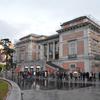More about Still Life with a Maid

Sr. Contributor
Frans Snyders liked to paint food in its many different forms, including fresh game.
He painted well over two dozen works of art with such titles as Kitchen Still Life, A Fruit Stall, The Fish Market, Still Life with Crab, Poultry and Fruit, The Pantry, Fruit and Vegetable Market, Venison Dealers, and, well, you get the idea. He really liked to paint things to eat, including the painting here, Fruit Girl (or Still Life with Maid, according to the Prado National Museum’s translation). Snyders was one of the first, if not the first, artist to paint “kitchen still lifes” in the Flemish Baroque style.
Snyders was also influenced by another Flemish master, Peter Paul Rubens, who was more of an action painter, but that’s another story. Snyders and Rubens actually worked together on a number of projects, including Philopoemen Recognized, which is a combination of the kitchen still life and a mythological painting. In this work, also at the Prado, Snyders did the still life part, while Rubens painted the figures in the background.
Paintings like this one were a way of showing off one’s wealth; besides the ability to afford the painting itself, the art showed the meal that may await the guests in the dining room, prepared by the servants, naturally. Back in the day, the kitchen in a wealthy household was very much separated from the dining areas, and the lord and lady of the manor probably didn’t spend much time there. That being said, the spread on this table is not that considerable, especially when compared to some of Snyders’ other works, where meat, vegetables, seafood, and large game are literally piled high and spilling onto the table.
While there seems to be no rhyme or reason in the arrangement of the fruits and vegetables, in some of these paintings there is actually a method to the madness. In the 17th century, there was a food hierarchy in the way the produce was painted that reflected the rarity and/or value of the items. Many times, the “lower” root vegetables would be relegated to the floor, while other, fancier foodstuff would be on the table. In this case, with no visible floor due to the closer view, the sumptuous-looking grapes, apples, and pears are in the basket, with the pumpkins resting on the table.
Artists from this era can be really big on the symbolism; Fruit Girl is no exception, and what do you know, all the symbols have to do with sex. Oh, I meant “fertility,” “marriage,” and “love” in art-history speak. The monkey is smelling a carnation, which can symbolize a wedding or fertility; the woman is holding a basket of figs, also symbolic of fertility and marriage, and lastly, the parrot nibbling on an apricot can be seen as a bird of love, and also of motherhood. Snyders used these symbols in his kitchen scenes in several other instances, too.
The “kitchen maid” in the Snyders painting doesn’t appear to be the least bit surprised that there is not only a parrot in the kitchen, but a monkey as well. She seems more amused than anything, because that’s just the way they rolled in a 17th century kitchen...at least one imagined by Frans Snyders.
Sources
- De Jongh, E. "Grape Symbolism in Paintings of the 16th and 17th Centuries." Simiolus: Netherlands Quarterly for the History of Art 7, no. 4 (1974): 166-91. doi:10.2307/3780485.
- Deutsche Welle. “What Works of Art Can Tell Us about the Evolution of Food: DW: 21.07.2020.” DW.COM. https://www.dw.com/en/what-works-of-art-can-tell-us-about-the-evolution….
- Machemer, Theresa. “Centuries-Old Paintings Help Researchers Track Food Evolution.” Smithsonian.com. Smithsonian Institution, July 23, 2020. https://www.smithsonianmag.com/smart-news/how-paintings-can-teach-us-ab….
- Robels, Hella, and Frans Snyders. Frans Snyders: Stilleben- Und Tiermaler, 1579-1657. München, Germany: Deutscher Kunstverlag, 1989.
- “Still Life with Fruit and Vegetables.” Norton Simon Museum. https://www.nortonsimon.org/art/detail/F.1973.16.P.
- Sullivan, Scott A. "Frans Snyders: Still Life with Fruit, Vegetables and Dead Game." Bulletin of the Detroit Institute of Arts 59, no. 1 (1981): 30-37. http://0-www.jstor.org.pacificatclassic.pacific.edu/stable/41504679.
- Vlieghe, Hans. Flemish Art and Architecture, 1585-1700. New Haven, CT: Yale University Press, 2004.











